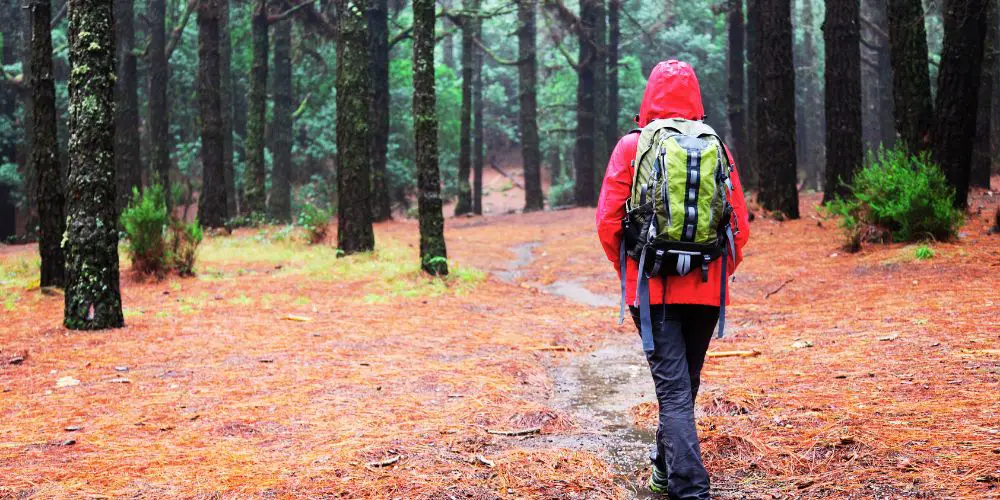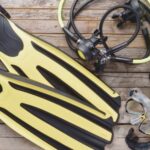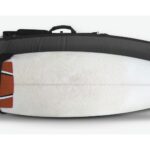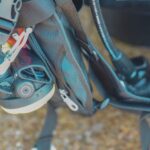Are you ready for the wild wonders of backpacking in the rain? I’ve got you covered with essential insights and tips. From gear selection to safety precautions, we’ll conquer rain-soaked adventures together.
Get ready to explore enchanting rain-kissed landscapes, stay dry with smart clothing, and master drying techniques. Discover sheltered camping spots and smart food storage, and stay informed with weather monitoring.
Plus, foot care tips for happy feet.
Let’s dive into this rainy backpacking extravaganza and embark on your next epic adventure!
Table of Contents
Choosing the Right RainGear
When backpacking in the rain, having the right gear is essential. One of the most crucial gear choices is a waterproof backpack. Look for a high-quality backpack with sealed seams and a rain cover. This will ensure your gear stays dry and protected from moisture, even during heavy downpours.
Waterproof Backpack
A high-quality waterproof backpack is essential to keep your gear dry and protected. Look for a backpack with sealed seams and a rain cover. Sealed seams ensure that water doesn’t seep through the stitching, while a rain cover adds an extra layer of protection.
Consider the size and compartments of the backpack to accommodate your belongings and keep them organized.
Rain Jacket
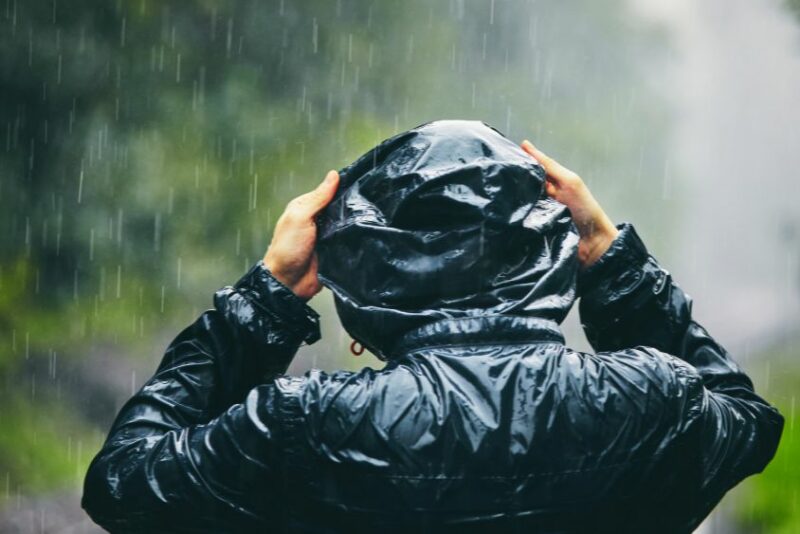
Investing in a reliable rain jacket is a game-changer for staying dry. Look for a jacket made of waterproof and breathable material, such as Gore-Tex or similar fabrics.
Waterproof materials prevent rain from penetrating the jacket, while breathable properties allow moisture and sweat to escape, keeping you comfortable. Features like taped seams, adjustable hoods, and cuffs provide additional protection against rain and wind.
Related: The Best Down Jackets.
Waterproof Pants or Rain Chaps
Opt for waterproof pants or rain chaps to keep your lower body dry. These garments are designed to repel water and keep you comfortable during wet conditions. Look for pants made from waterproof materials with sealed seams.
Consider the fit and features like adjustable waistbands or leg openings for a customized fit. Rain chaps are an alternative option that covers the lower portion of your legs and can be worn over regular hiking pants.
Waterproof Hiking Boots or Gaiters
Your footwear plays a vital role in keeping your feet dry and comfortable. Choose waterproof hiking boots, or consider using gaiters with non-waterproof boots.
Waterproof hiking boots with sealed seams and materials are designed to keep water out. Conversely, gaiters are protective coverings that wrap around your ankles and lower legs, providing an additional barrier against water and debris.
Rainfly or Waterproof Tent
When camping in the rain, having a rainfly or waterproof tent is essential for staying dry and comfortable throughout the night. A rainfly is an additional layer that goes over your tent to protect it from rain and moisture.
Look for a rainfly made of waterproof material that provides full coverage for your tent. Alternatively, consider investing in a waterproof tent to repel water and keep you dry even in heavy rainfall.
Related: 5 Best Travel Backpacks For Fat Guys.
How To Dress For Rainy Conditions
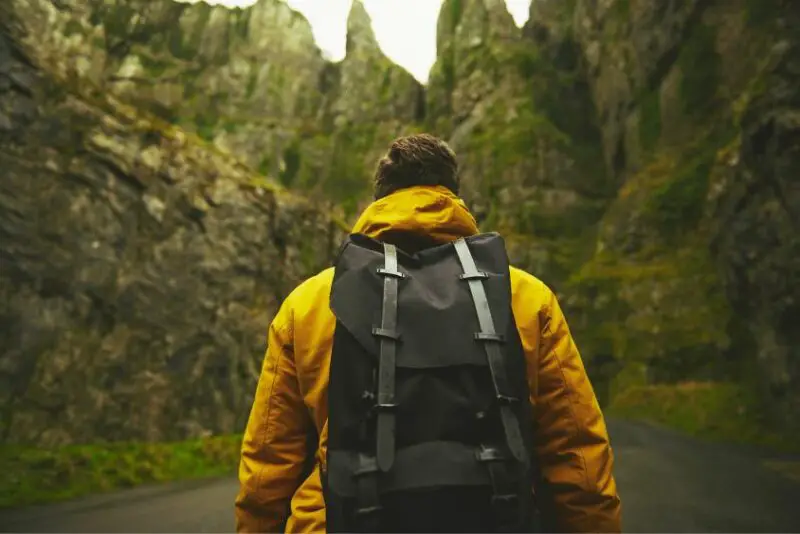
When it comes to dressing for rainy conditions during backpacking, it’s all about finding the right combination of layers to keep you dry, comfortable, and protected.
Moisture-Wicking Base Layer
Start with a moisture-wicking base layer, typically made of synthetic or merino wool material. This layer draws sweat away from your skin, keeping you dry and preventing moisture buildup.
Look for base layers with quick-drying properties, allowing them to manage moisture efficiently during your rainy adventures.
Insulating and Breathable Mid-Layers
Layering is key to regulating your body temperature in varying weather conditions. Add insulating and breathable mid-layers on top of your base layer. These include fleece jackets, synthetic or down-filled vests, or lightweight insulated jackets.
Opt for materials that offer warmth even when wet and have breathability to prevent overheating.
Waterproof and Breathable Outer Layer (Rain Jacket)
The outer layer, a rain jacket, is your first defense against rain and wind. Choose a waterproof and breathable rain jacket made of materials like Gore-Tex or similar fabrics.
Look for taped seams, adjustable hoods, and cuffs to ensure maximum protection. The jacket should effectively repel rain while allowing moisture and heat to escape, keeping you comfortable throughout your trek.
Related: Down vs. Synthetic Jacket: 11 Talking Points.
Waterproof Pants or Rain Skirts
Invest in waterproof pants or wear rain skirts to dry your lower body. Waterproof pants are typically made of materials like Gore-Tex and feature sealed seams to prevent water from seeping through.
They provide full coverage and protection against rain and wet terrain. Rain skirts are an alternative option covering the lower body, allowing for better ventilation while keeping you dry.
Waterproof Gloves and Waterproof Hat or Hood
Protecting your extremities is essential in wet conditions. Wear waterproof gloves to keep your hands dry and warm. Look for gloves made of waterproof materials with a comfortable fit.
Additionally, don a waterproof hat or hood to shield your head from rain. This will help prevent water from trickling down your neck and keep you dry and comfortable.
How To Stay Safe During Rainy Backpacking

Ensuring your safety during rainy backpacking adventures is of utmost importance. Let’s look at how you should stay safe while backpacking in the rain.
Be cautious of slippery surfaces and adjust your pace accordingly
Exercise caution when trekking on wet and slippery surfaces and adjust your pace to prevent accidents. Slow down your steps and maintain a stable footing, using techniques like taking smaller strides and planting your feet firmly.
Be mindful of rocks, tree roots, and other hazards that may become more slippery in the rain. Take your time and stay vigilant throughout your journey.
Avoid open areas and seek shelter during thunderstorms or lightning.
It’s crucial to seek shelter immediately during thunderstorms or when lightning is present. Avoid open areas, exposed ridges, and tall, isolated trees, as they pose a higher risk of being struck by lightning.
Look for natural shelters like caves or rock overhangs, or set up your rainfly or waterproof tent in a safe location. If no shelter is available, find a low-lying area away from tall objects and crouch down, minimizing your contact with the ground.
Related: Best Backpacks For A 3-Day Trip.
Cross rivers or streams with caution, using trekking poles for stability
When encountering rivers or streams, exercise caution before attempting to cross. Assess the water’s depth and speed, and if unsure, consider alternative routes or wait for conditions to improve.
Use trekking poles for added stability and balance while crossing. Before fully committing your weight, test each step and maintain a wide stance for better stability. Waiting or finding an alternate crossing point is safer if the water level is too high or the current is strong.
Be aware of potential flash floods and choose elevated camping spots.
In areas prone to flash floods, it’s essential to be aware of the risks and take precautions. Monitor weather forecasts and local advisories to stay informed about potential flash flood conditions.
When choosing a camping spot, select an elevated area away from riverbanks or low-lying areas susceptible to flooding. Set up your tent on higher ground to minimize the risk of water pooling around your campsite.
Inform someone about your itinerary and expected return time.
Before embarking on your rainy backpacking trip, always inform someone you trust about your itinerary and expected return time. Share details of your planned route, camping locations, and any side trips you may take.
This information will be crucial in emergencies or if you fail to return as scheduled. Consider using a reliable communication device or leaving a note with the details in your vehicle or home.
Related: Travel Safety 101: 22 Tips for a Secure Journey.
Staying Dry During Sleep (For Camping Trips)
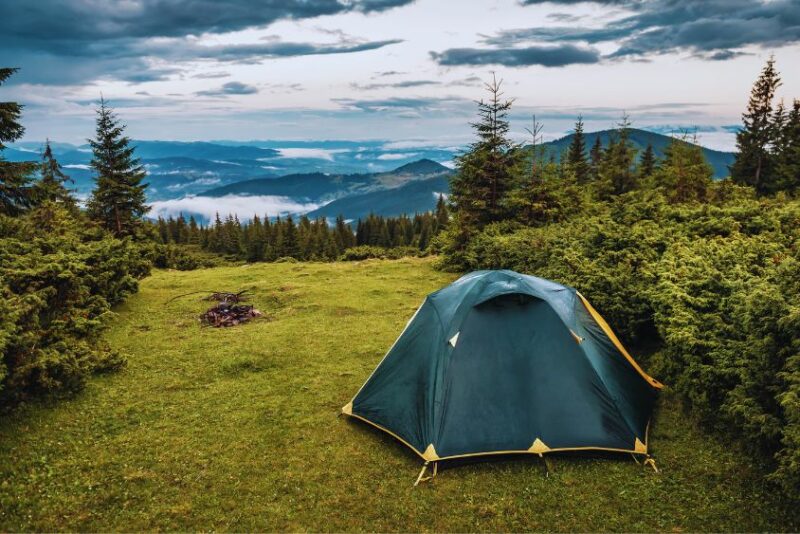
If you are backpacking for camping trips, these tips are applied to you. Ensuring a dry and comfortable sleep during rainy backpacking trips is essential for overall well-being.
Choose a tent with a bathtub-style floor and a rainfly for maximum rain protection.
When selecting a tent for rainy conditions, choose one with a bathtub-style floor design. This design features raised sides extending a few inches above the ground as a barrier against water seepage.
Additionally, ensure your tent comes with a rainfly—a waterproof cover that goes over the tent—to provide an extra layer of protection against rain.
Set up your tent in a location with proper drainage and avoid depressions or potential runoff areas.
Choosing the right tent location is crucial for staying dry during sleep. Look for a spot with proper drainage, preferably on slightly elevated ground where rainwater won’t accumulate.
Avoid areas prone to depressions or potential runoff, as they can become pooling points for water. Take note of the land’s natural contours and select a spot to minimize the chances of water seeping into your tent.
Use a groundsheet or footprint to create an additional barrier against ground moisture.
To further protect against ground moisture, utilize a groundsheet or footprint underneath your tent. These waterproof and durable materials act as an extra layer of defense, preventing water from seeping through the tent floor.
Ensure the groundsheet or footprint is slightly smaller than the tent footprint to prevent rainwater from collecting between the layers.
Properly stake your tent and ensure it is taut to prevent water from pooling.
Properly staking your tent is essential to maintain its stability and prevent water from pooling. Tautly pitch your tent, ensuring the rainfly is extended fully and tightly secured.
Proper tension on the tent fabric will help rainwater slide off smoothly, minimizing pooling risk. Regularly check and readjust the stakes and guy lines if necessary to maintain the tautness of the tent.
Keep your sleeping bag and other gear elevated on a dry mat or in dry bags
Elevating your sleeping bag and gear is crucial to prevent moisture absorption. Use a dry mat or a waterproof barrier to separate your gear and the ground. This will help prevent moisture from seeping into your sleeping bag and keep it dry.
Additionally, use dry bags or waterproof stuff sacks to store your gear and clothing, ensuring they remain protected from rain or accidental water exposure.
See more tips about how to stay dry in the rain here.
Navigating Rainy Terrain During Backpacking In The Rain
Navigating rainy terrain during backpacking requires extra attention and caution to ensure your safety and enjoyment.
Be mindful of slippery and muddy trails, adjusting your footing and pace accordingly.
Rainy conditions often result in slippery and muddy trails, increasing the risk of slips and falls. Stay attentive to your surroundings and adjust your footing and pace accordingly.
Take shorter strides, plant your feet firmly, and distribute your weight evenly to maintain stability. Be cautious when traversing steep or rocky sections, as they may become more challenging in wet conditions.
Use trekking poles for added stability and balance on uneven terrain
Trekking poles are invaluable companions when navigating rainy terrain. They provide additional stability, balance, and support, particularly on uneven and slippery surfaces.
Use them to distribute weight, gain traction, and maintain stability on challenging terrain. Trekking poles also help reduce stress on your knees and joints, making your hike more comfortable and safer.
Choose alternative routes or trails with less exposure to hazards during heavy rainfall.
Some trails may become more hazardous during heavy rainfall due to increased water flow, potential landslides, or unstable terrain. Consider choosing alternative routes or trails that offer less exposure to these hazards.
Research trail conditions and consult local authorities or experienced hikers for advice on safer alternatives. It’s better to err on the side of caution and prioritize your safety.
Watch out for potential water crossings and assess their safety before proceeding.
Rainfall can significantly affect water levels in rivers, streams, and other water crossings along the trail. Exercise caution when encountering such crossings and assess their safety before proceeding.
Consider any makeshift bridges or logs’ depth, current strength, and stability. If uncertain about the safety of a water crossing, wait for water levels to subside, seek advice from local hikers, or consider finding an alternative route.
Check weather forecasts and trail conditions before embarking on your backpacking trip.
Check weather forecasts and trail conditions before heading out on your backpacking adventure. Rain can significantly impact trail difficulty, safety, and overall experience.
Be aware of any warnings or advisories park authorities or trail organizations issued. Stay updated on the weather forecast to anticipate changing conditions and adjust your plans accordingly.
This proactive approach ensures you’re well-prepared for the challenges that may arise on the trail.
How To Dry Wet Gear And Clothing
Drying wet gear and clothing is crucial for maintaining comfort and preventing mildew during backpacking trips in the rain. Here are some tips:
Hang wet clothing and gear inside your tent or under a sheltered area to air dry.
After a rainy hike, hang your wet clothing and gear inside your tent or under a sheltered area to allow them to air dry. Utilize the available space using gear loops, clotheslines, or hooks inside the tent.
Keep the wet items away from your sleeping area to prevent moisture transfer. Ventilate the tent by partially opening doors or vents to facilitate airflow and aid in the drying process.
Utilize natural heat sources like the sun or warm rocks to aid in drying.
Take advantage of natural heat sources to speed up the drying process. If the sun shines, hang your wet gear and clothing in direct sunlight. The sun’s warmth and UV rays will help evaporate moisture more quickly.
Alternatively, you can place your items on warm rocks or other surfaces that absorb and radiate heat. Remember to periodically rotate the items for even drying.
Use absorbent microfiber towels to remove excess moisture from gear and clothing.
Before drying your wet gear and clothing, use absorbent microfiber towels to remove excess moisture. Pat dry the items to absorb as much water as possible. Focus on areas with high saturation, such as cuffs, collars, and seams.
This step helps speed up the drying process and prevents excess water from dripping into your tent or backpack.
Apply waterproofing treatments or reapply DWR coatings as necessary.
GEAR AID Revivex Durable Water Repellent (DWR)
To maintain the water repellency of your gear and clothing, apply waterproofing treatments or reapply Durable Water Repellent (DWR) coatings as needed. Follow the manufacturer’s instructions for proper application.
Waterproofing treatments restore the water resistance of items like jackets, pants, and footwear, ensuring they repel water effectively.
Ensure all gear is completely dry before packing to prevent mildew and odors.
Before packing your gear and clothing, ensure they are completely dry. Even small amounts of moisture can lead to mildew growth and unpleasant odors. Double-check the drying status by touching and inspecting each item.
Pay attention to hidden pockets, seams, and folds. Extend drying time or reposition the items to ensure thorough drying. Packing dry gear ensures freshness and helps preserve the lifespan of your equipment.
Stay Hygiene and Protect Electronics in Wet Conditions
Maintaining hygiene and protecting electronics are essential when backpacking in wet conditions.
Maintain personal hygiene using wet wipes, hand sanitizer, and biodegradable soap.
Even in wet conditions, it’s important to prioritize personal hygiene. Carry wet wipes or biodegradable soap to clean your hands and body. These items help remove dirt, sweat, and bacteria, keeping you fresh and preventing potential infections.
Hand sanitizer is also useful when water for handwashing is scarce. Remember to properly dispose of wet wipes and use biodegradable soap to minimize environmental impact.
Protect electronic devices and gadgets with waterproof cases or dry bags
Earth Pak -Waterproof Dry Bag
Invest in waterproof cases or dry bags to safeguard your electronic devices and gadgets from water damage. These protective accessories provide a barrier against water, preventing moisture from reaching your devices.
Waterproof cases are designed for various electronics, including smartphones, cameras, and GPS devices. On the other hand, dry bags are versatile and can accommodate multiple items.
Always double-check the seal and test the waterproof capabilities before exposing your electronics to water.
Keep spare batteries, power banks, or solar chargers for extended trips
When backpacking in wet conditions, it’s essential to have reliable power sources for your electronic devices. Carry spare batteries for devices that require them, such as headlamps or GPS units.
Power banks offer a convenient way to charge devices on the go. Opt for waterproof or water-resistant models to ensure their functionality in wet conditions. Solar chargers are another option for extended trips, allowing you to harness solar energy to recharge your devices during the day.
How To Prevent Foot Issues In Rainy Backpacking
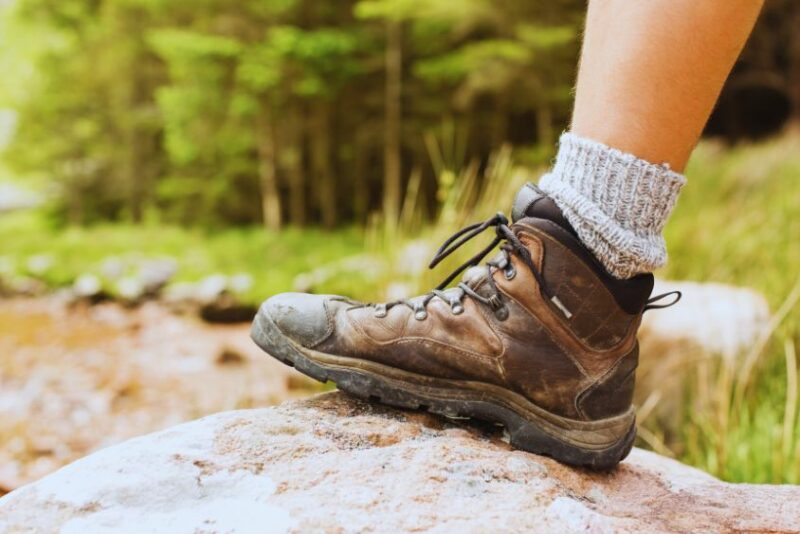
Preventing foot issues is crucial for maintaining comfort and mobility during rainy backpacking trips.
Choose moisture-wicking and quick-drying socks made of synthetic or merino wool material.
Selecting the right socks is essential for managing moisture and keeping your feet dry. Opt for moisture-wicking socks made of synthetic or Merino wool material.
These materials effectively draw moisture away from your skin, preventing excessive sweating and reducing the likelihood of blisters. Additionally, choose socks with quick-drying properties to minimize discomfort caused by wet feet.
Use well-fitting, waterproof hiking boots or trail shoes with proper traction.
Investing in well-fitting, waterproof hiking boots or trail shoes is crucial for protecting your feet from rain and wet conditions. Ensure that your footwear is designed to withstand rain and has a waterproof membrane to prevent water from seeping in.
Properly fitting boots or shoes with ample toe room and good arch support reduce the risk of blisters and provide stability on wet and slippery surfaces. Look for outsoles with aggressive treads for reliable traction.
Apply foot powder or lubricant to reduce friction and prevent blisters.
To minimize friction and prevent blisters, apply foot powder or lubricant to your feet before putting on your socks. Foot powder helps absorb moisture and reduces friction between your feet and socks, keeping them dry and preventing chafing.
Lubricants, such as petroleum jelly or specialized anti-blinker balms, create a protective barrier and reduce friction on vulnerable areas, such as heels and toes.
Dry and air out your feet and footwear during breaks to prevent fungal growth
During breaks or when setting up camp, take the opportunity to dry and air out your feet and footwear. Remove your socks and allow your feet to breathe. Place your shoes or boots in a well-ventilated area or under a shelter to dry.
Avoid leaving them in direct sunlight or near a heat source, as excessive heat can damage the materials. Drying your feet and footwear helps prevent fungal growth and keeps them fresh for the next day’s adventures.
Conclusion
Backpacking in the rain can be exciting and rewarding. With the right gear, clothing, and knowledge of safety precautions, you can navigate through wet conditions comfortably and enjoy the beauty of nature.
Additionally, proper drying techniques, understanding camping spots, food storage, weather monitoring, hygiene, and foot care will contribute to a successful rainy backpacking experience.
So, prepare yourself, embrace the rain, and embark on unforgettable journeys filled with awe-inspiring landscapes and cherished memories.
Happy backpacking!
